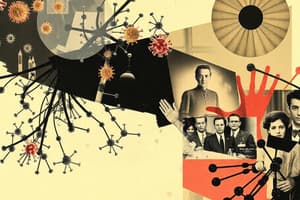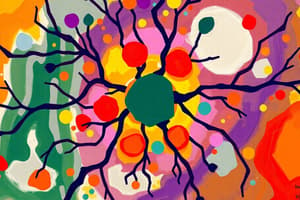Podcast
Questions and Answers
Which function is primarily associated with humoral immunity?
Which function is primarily associated with humoral immunity?
- Defense against extracellular microbes and microbial toxins. (correct)
- Activation of T cells.
- Direct killing of infected cells.
- Defense against intracellular microbes.
How do antibodies contribute to the neutralization of microbes?
How do antibodies contribute to the neutralization of microbes?
- By blocking the microbe's ability to bind to host cells. (correct)
- By activating complement pathways.
- By enhancing the microbe's replication within host cells.
- By directly lysing the microbe's cell wall.
Opsonization, a function of antibodies, enhances which process?
Opsonization, a function of antibodies, enhances which process?
- Inhibition of complement activation.
- Viral replication.
- Phagocytosis. (correct)
- Direct activation of T cells.
Which antibody isotype is primarily involved in antibody-dependent cell-mediated cytotoxicity (ADCC) by binding to NK cells?
Which antibody isotype is primarily involved in antibody-dependent cell-mediated cytotoxicity (ADCC) by binding to NK cells?
Which antibody isotype primarily mediates mucosal immunity?
Which antibody isotype primarily mediates mucosal immunity?
Neonatal immunity is primarily conferred by which mechanism?
Neonatal immunity is primarily conferred by which mechanism?
Which antibody isotype is characteristic of the primary immune response?
Which antibody isotype is characteristic of the primary immune response?
What is a distinguishing characteristic of the secondary immune response compared to the primary response?
What is a distinguishing characteristic of the secondary immune response compared to the primary response?
The increased speed and magnitude of the secondary immune response is due to?
The increased speed and magnitude of the secondary immune response is due to?
What immunological process allows for the switch from IgM to IgG production in the secondary immune response?
What immunological process allows for the switch from IgM to IgG production in the secondary immune response?
What is the primary function of cell-mediated immunity?
What is the primary function of cell-mediated immunity?
CD4+ T helper cells differentiate into which effector cell types based on cytokine production?
CD4+ T helper cells differentiate into which effector cell types based on cytokine production?
Which type of cell-mediated immunity is most effective against helminthic infections and allergies?
Which type of cell-mediated immunity is most effective against helminthic infections and allergies?
What is the primary function of CD8+ T cells?
What is the primary function of CD8+ T cells?
What two signals are required for the activation of T cells?
What two signals are required for the activation of T cells?
What occurs if a T cell receives the first signal (peptide + MHC) without the second co-stimulatory signal?
What occurs if a T cell receives the first signal (peptide + MHC) without the second co-stimulatory signal?
Which of the following accurately describes the steps of killing of infected cells by CD8+ CTLs?
Which of the following accurately describes the steps of killing of infected cells by CD8+ CTLs?
What is the role of perforin in the killing of infected cells by CTLs?
What is the role of perforin in the killing of infected cells by CTLs?
What is the function of granzymes in the context of CTL-mediated cell death?
What is the function of granzymes in the context of CTL-mediated cell death?
The major histocompatibility complex (MHC) is responsible for?
The major histocompatibility complex (MHC) is responsible for?
Which chromosome contains the genes encoding the MHC molecules in humans?
Which chromosome contains the genes encoding the MHC molecules in humans?
What is the primary function of MHC class I molecules?
What is the primary function of MHC class I molecules?
Which of the following cell types expresses MHC class I molecules?
Which of the following cell types expresses MHC class I molecules?
What is the role of MHC class II molecules?
What is the role of MHC class II molecules?
On which cells are MHC class II molecules primarily expressed?
On which cells are MHC class II molecules primarily expressed?
What is the function of the beta-2 microglobulin associated with MHC class I molecules?
What is the function of the beta-2 microglobulin associated with MHC class I molecules?
What cells type, when activated and releasing IL-4 and IL-5, would most likely contribute to eosinophil activation?
What cells type, when activated and releasing IL-4 and IL-5, would most likely contribute to eosinophil activation?
Which of these is the co-stimulatory signal needed for activation of T cells?
Which of these is the co-stimulatory signal needed for activation of T cells?
Which would be the outcome after exposure of T cells to antigen lead to the anergy?
Which would be the outcome after exposure of T cells to antigen lead to the anergy?
Flashcards
Humoral Immunity
Humoral Immunity
Immunity mediated by secreted antibodies, defending against extracellular microbes and toxins.
Cell-Mediated Immunity
Cell-Mediated Immunity
Immunity involving activation of T cells to eliminate intracellular microbes.
Neutralization
Neutralization
Antibodies block microbes/toxins binding to cells, preventing infection.
Opsonization
Opsonization
Signup and view all the flashcards
ADCC
ADCC
Signup and view all the flashcards
Complement Activation
Complement Activation
Signup and view all the flashcards
Mucosal Immunity (IgA)
Mucosal Immunity (IgA)
Signup and view all the flashcards
Neonatal Immunity (IgG)
Neonatal Immunity (IgG)
Signup and view all the flashcards
Primary Response
Primary Response
Signup and view all the flashcards
Secondary Response
Secondary Response
Signup and view all the flashcards
Immunologic Memory
Immunologic Memory
Signup and view all the flashcards
Class Switching
Class Switching
Signup and view all the flashcards
CD4+ T cell Differentiation
CD4+ T cell Differentiation
Signup and view all the flashcards
TH1 Function
TH1 Function
Signup and view all the flashcards
TH2 Function
TH2 Function
Signup and view all the flashcards
CD8+ T Cells
CD8+ T Cells
Signup and view all the flashcards
T cell Activation: 1st signal
T cell Activation: 1st signal
Signup and view all the flashcards
T cell Activation: 2nd signal
T cell Activation: 2nd signal
Signup and view all the flashcards
T cell Anergy
T cell Anergy
Signup and view all the flashcards
CTL Recognition
CTL Recognition
Signup and view all the flashcards
CTL Killing Mechanisms
CTL Killing Mechanisms
Signup and view all the flashcards
Major Histocompatibility Complex
Major Histocompatibility Complex
Signup and view all the flashcards
MHC Class I Genes
MHC Class I Genes
Signup and view all the flashcards
MHC Class II Genes
MHC Class II Genes
Signup and view all the flashcards
MHC molecule
MHC molecule
Signup and view all the flashcards
Class I MHC molecules
Class I MHC molecules
Signup and view all the flashcards
Class II MHC molecules
Class II MHC molecules
Signup and view all the flashcards
Study Notes
- Adaptive immunity and MHC Module: Foundations of Immunology BMS172
Instructor Information
- Contact the instructor, Professor Doctor Mohammed Mahmoud El-Naggar at [email protected]
- The department is Medical Microbiology and Immunology
- The instructor's mobile number is 01126625177
- Academic hours are Sundays from 10:00 AM to 12:00 AM
Learning Outcomes
- Describe types of adaptive immunity
- Identify functions of antibody isotypes
- Compare primary and secondary humoral immune responses
- Identify types of cell-mediated immunity
- Define MHC
- Describe MHC classes
- Describe MHC structure
- Describe MHC distribution
- Describe MHC function
Lecture Outline
- Types of adaptive immunity (humoral and cellular)
- Primary and secondary humoral immune response
- Types of cell-mediated immunity
- Major histocompatibility complex
Adaptive Immunity Types
- Adaptive immunity includes humoral and cell-mediated immunity
Humoral Immunity
- Humoral immunity is mediated by secreted antibodies
- It defends against extracellular microbes and microbial toxins
Functions of Antibody Isotypes
- Neutralization of microbes and microbial toxins involves antibodies blocking microbe binding to cells, thus preventing infection
- Neutralization involves antibodies inhibiting microbe spread from infected to adjacent cells
- Neutralization involves antibodies blocking toxin binding to cellular receptors, inhibiting toxin's pathological effects
- Antibodies of the IgG isotype coat microbes promoting their phagocytosis by binding to Fc receptors on phagocytic cells like neutrophils and macrophages
- IgG binds to infected cells via Fab regions and to Fc receptors on NK cells via Fc regions, activating NK cells to kill
- IgE binds to helminthic parasites via Fab regions and to Fc receptors on eosinophils via Fc regions which activates eosinophils to release granule contents that kill the parasites
Activation of the Complement
- IgG and IgM activate the complement system
Antibody Function
- Mucosal immunity is where IgA, the major antibody class produced by mucosa-associated lymphoid tissues (MALT) in the GIT and RT, is transported to organ lumens
- In mucosal secretions, IgA binds to and neutralizes microbes and toxins by blocking their entry
- Neonatal immunity is where neonates are protected from infection by maternal IgG antibodies transported across the placenta, and by ingested milk antibodies transported across the gut epithelium
Primary Immune Response
- There is a lag of about 10 days before a specific antibody becomes detectable after the first exposure to an antigen
- The primary response antibody is IgM
- Antibody levels decline after a short time
Secondary Immune Response
- Re-exposure to the same antigen induces a more rapid antibody appearance
- A greater amount of antibody is produced
- The antibody class is IgG
- Antibodies remain detectable for months or years
- Exposure to a different antigen at the same time results in a primary response to the new antigen
Primary vs Secondary Immune Response
| Primary Response | Secondary Response | |
|---|---|---|
| Onset | Slow | Rapid |
| Magnitude | Low | High |
| Duration | Short Lived | Long Lived |
| Antibody | IgM | IgG (or IgA, or IgE) |
- The immune system possesses specific immunologic memory for antigens
- The secondary response is possible because of the immune system possessing specific immunologic memory for antigens
- B lymphocytes become memory cells during the primary response leading to class switching from IgM to IgG during the secondary response
Cell-Mediated Immunity
- Cell-mediated immunity eradicates infections by intracellular microbes
- Naïve T cells activate, proliferate, and differentiate into effector cells e.g. CD4+ T helper cells and CD8+ cytolytic cells (CTLs)
- Then intracellular microbes are eliminated
Types of Cell-Mediated Immunity
- CD4+ T cells differentiate into two effector cell types based on cytokine production by the antigen-presenting cell
- IL-12 leads to Th1 differentiation
- IL-4 leads to Th2 differentiation
- Th1 cells secrete IFN-γ, activating phagocytes to kill microbes
- Th2 cells secrete IL-4 and IL-5, stimulating eosinophil and mast cell degranulation in allergy and helminthic infection
- CD8+ T cells kill cells containing microbes or microbial proteins in the intracellular by direct cell cytotoxicity, eliminating the reservoir of infection
Activation of T Cells
- Peptide + MHC on the surface of APCs are recognized by TCR-CD3
- The interaction of B7 molecules on APCs with CD28 on T cells.
- Exposure of T cells to an antigen in the absence of a second signal i.e. co-stimulatory signal leads to unresponsiveness or anergy
Killing of Infected Cells
- CD8+ CTLs recognize class I MHC + peptides on the surface of infected "target" cells"
- Tight adhesions form between CTLs and target cells
- CTLs are activated by IL-2 and IFN-γ to release their granule contents toward the target cell via exocytosis
Granule Contents
- Perforin forms pores in the target cell membrane
- Granzymes enter target cells through the pores, inducing apoptosis by activating caspases
- CTLs detach from target cells to kill other target cells
- Target cells die
Major Histocompatibility Complex Definition
- MHC is a group of genes on the short arm of chromosome 6
- MHC produces molecules present on cell surfaces
- MHC is responsible for displaying protein Ag to T cells
- MHC is also called human leucocytic Ag = HLA
Classification of Genes
| MHC Class | Function |
|---|---|
| Class I MHC genes | Role in Ag presentation to Tc, includes HLA-A, HLA-B, HLA-C |
| Class II MHC genes | Role in Ag presentation to Th, includes HLA-D region (HLA-DR & HLA-DP & HLA-DQ) |
| Class III MHC genes | Lies between class I & II & not produce MHC but produce some complement components & TNF-α. |
Structure and Distribution of MHC Molecules
- They consist of an extracellular, transmembrane, and cytoplasmic part that anchors the molecule to the cell
- MHC molecules are membrane proteins expressed on cells
Class I Molecules
- Includes two polypeptide chains, an α chain of 3 domains (α1, α2, α3), attached to a β2 microglobulin encoded by a gene outside MHC
- Alpha 1 and alpha 2 domains form the peptide-binding cleft
- Class I presents antigen to CD8+ cells
- Class I molecules are expressed on all nucleated cells
Class II Molecules
- Includes two polypeptide chains, an α chain (α1 & α2) and β chain (β1 & β2)
- Alpha 1 and beta 1 domains form the peptide-binding cleft
- Class II presents antigen to CD4+ cells
- Class II is expressed on APCs only
Case Study
- A 65-year-old man with chronic renal failure received a kidney transplant from a blood group-matched friend
- Two weeks post-transplant, the man's creatinine levels rose continuously and he was told that he would have to go back to renal dialysis
Potential Questions to Consider
- What is the proper diagnosis?
- What test should you concentrate on for the next operation for this man?
Studying That Suits You
Use AI to generate personalized quizzes and flashcards to suit your learning preferences.



